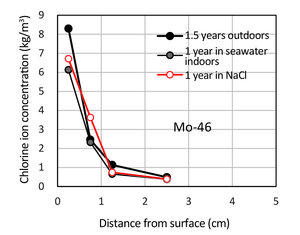Major Research Evaluation of longterm durability of concrete, steel and various materials based on exposure test
Port and airport facilities are generally required to have the useful lives of 50 to 100 years. On the other hand, the environment in which they are located is extremely harsh, being a marine environment. Longterm durability evaluation of various types of construction materials (concrete, steel, anti-corrosion agents, etc.) under such harsh environment will be evaluated based on exposure tests under the same actual environmental conditions will be expected. In this study, we are assessing the long-term durability of various construction materials in marine conditions based on long-term exposure tests conducted under the same actual environmental conditions as those where they would be used, to provide useful information for deciding which materials might be suitable for constructing specific facilities. Our main activities conducted in FY 2021 are as follows.
We examined methods of predicting chlorine-induced concrete deterioration (salt diffusion characteristics, etc.) and studied how concrete itself progressively degrades under the effects of seawater, etc. We conducted exposure and other tests in seawater circulation tanks and actual environments and examined the intensive corrosion mechanism that affected steel components, along with the cathodic protection characteristics that would typically manifest near L.W.L. We studied the durability of various wood materials in seawater and air.

Result of test on Moroccan-made concrete
(chlorine ion penetration after 1.5 years of exposure)



